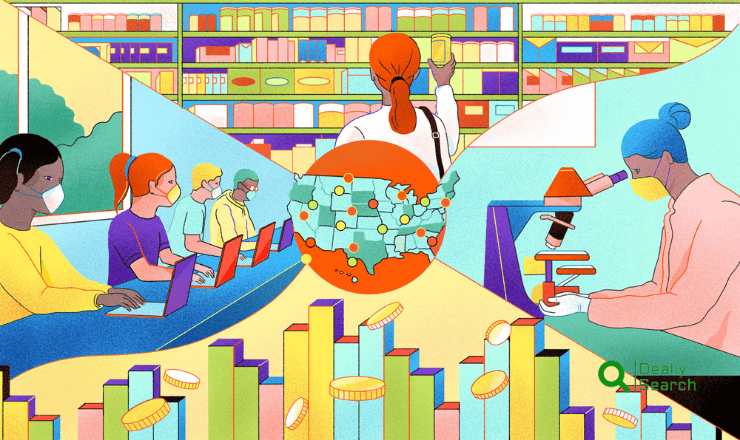Innovative Tech Solutions to Overcome Global Resource Shortages

In an era marked by significant resource shortages across various sectors, technology stands as a beacon of hope, offering innovative solutions that promise to mitigate these shortages and revolutionize how industries operate. Resource shortage refers to a situation where the demand for a specific resource (such as raw materials, labor, or energy) exceeds its availability, leading to supply gaps, price increases, and potential economic or operational disruptions. From healthcare to agriculture, integrating advanced technologies is transforming resource management and availability. This blog post explores the emerging tech solutions to tackle resource shortages in different industries and how they contribute to a more efficient and sustainable global economy.
Harnessing Robotic Process Automation (RPA) In Healthcare
Robotic Process Automation (RPA) in healthcare enhances efficiency by automating administrative tasks, reducing errors, improving patient data management, and streamlining billing, enabling healthcare professionals to focus on patient care.

Alleviating Staff Shortages with Automation
A global shortfall of healthcare workers severely impacts the healthcare industry and is projected to reach 18 million by 2030. Robotic Process Automation (RPA) offers a viable solution to this crisis by automating routine administrative tasks, thus freeing up medical staff to focus on patient care. Critical implementations of RPA include:
- Automating Claim Processing: Streamlines the handling of patient claims, reducing the time and workforce required for data entry and verification.
- Enhancing Appointment Scheduling: Utilizes bots for scheduling patient appointments, significantly reducing the burden of manual scheduling and minimizing appointment no-shows.
Streamlining Administrative Workflows
RPA enhances operational efficiency and significantly cuts administrative costs, which are often double or triple the costs of managing direct patient care in the U.S. By automating these processes, healthcare providers can allocate more resources to patient care, improving outcomes and patient satisfaction.
Advancements in 3D Printing to Combat Equipment Shortages
Advancements in 3D printing help combat equipment shortages by enabling rapid production of medical devices, prosthetics, and protective gear, ensuring cost-effective, customizable, and on-demand solutions for healthcare and manufacturing industries.

On-Demand Manufacturing of Medical Supplies
3D printing technology is pivotal in addressing the shortages of medical equipment. By enabling local, on-demand production of essential medical tools and devices, this technology ensures that healthcare providers have timely access to necessary resources. Benefits include:
- Decentralized Production: Reduces dependency on complex supply chains, especially beneficial in remote areas.
- Customized Medical Devices: Allows for the production of patient-specific devices, enhancing the effectiveness of medical treatments.
Predictive Analytics for Efficient Resource Management
Predictive analytics uses historical data and machine learning to forecast future equipment needs, optimizing inventory and maintenance schedules. This helps avoid equipment shortages and extends the lifespan of medical devices, thus saving costs and resources.
Types Of Tech Solutions For Resource Shortages
Technology plays a crucial role in mitigating resource shortages by improving efficiency, enhancing conservation, and enabling better resource management. Here are different types of tech solutions that help address resource shortages across various sectors:
Smart Water Management Technologies
Water scarcity is a major issue in many regions, and technology can optimize water usage and prevent wastage.
IoT-Based Water Monitoring Systems: Smart sensors detect leaks and track water usage in real-time.
Example: Smart meters in homes and industries provide real-time data on consumption.
Desalination Technology: Converts seawater into freshwater through reverse osmosis or nanotechnology.
Example: Solar-powered desalination plants for coastal regions with water shortages.
Water Recycling And Reuse Systems: Advanced filtration and purification techniques allow wastewater to be reused.
Example: Greywater recycling in buildings for irrigation and toilet flushing.
Agricultural And Food Technology
Food shortages can be addressed through innovations in agriculture and food production.
Precision Agriculture: Uses AI, IoT, and drones to monitor soil conditions, optimize irrigation, and maximize crop yield.
Example: Farmers use satellite data to determine when and where to plant crops.
Hydroponics And Vertical Farming: Growing crops without soil using nutrient-rich water solutions, allowing food production in urban areas.
Example: Indoor farms use LED lighting and automation for year-round crop growth.
Lab-Grown And Alternative Proteins: Producing meat substitutes using plant-based ingredients or lab-cultured meat to reduce strain on livestock farming.
Example: Companies like Beyond Meat and Impossible Foods provide meat alternatives.
Food Waste Reduction Apps: Mobile apps connect food producers with consumers to reduce food wastage.
Example: Apps like Too Good To Go help restaurants sell surplus food at reduced prices.
Renewable Energy Technologies
Energy shortages can be tackled through sustainable energy solutions.
Solar And Wind Power Systems: Solar panels and wind turbines generate clean energy, reducing reliance on fossil fuels.
Example: Smart grids distribute solar energy efficiently to homes and industries.
Energy Storage Solutions: Advanced batteries (e.g., lithium-ion, solid-state) store renewable energy for consistent power supply.
Example: Tesla Powerwall stores solar energy for home use.
Hydrogen Fuel Technology: Hydrogen fuel cells produce clean energy with water as a byproduct, offering an alternative to fossil fuels.
Example: Hydrogen-powered vehicles and industrial applications.
Smart Grid Systems: AI-powered electricity distribution systems that optimize energy consumption and prevent blackouts.
Example: Automated demand response systems adjust power supply based on real-time demand.
Smart Infrastructure And Urban Planning
Housing and infrastructure shortages can be addressed with smart solutions.
3D Printing For Construction: Rapid construction of homes using 3D-printed materials, reducing waste and costs.
Example: 3D-printed houses built in hours for disaster-stricken areas.
IoT-Enabled Smart Cities: AI and sensor-based systems optimize traffic, waste management, and energy use.
Example: Smart streetlights that adjust brightness based on real-time usage.
Affordable Housing Solutions: AI-driven design tools create cost-effective housing solutions.
Example: Modular housing units that can be built and transported quickly.
Healthcare And Medical Resource Optimization
Shortages of medical resources can be tackled with technology.
Telemedicine And AI Diagnostics: Remote healthcare services through video calls and AI-powered diagnosis tools.
Example: AI chatbots analyze symptoms and suggest treatments before seeing a doctor.
3D-Printed Medical Supplies: Producing prosthetics, implants, and surgical tools quickly and affordably.
Example: 3D-printed ventilators during COVID-19 pandemic.
Automated Drug Manufacturing: AI and robotics speed up the production of essential medicines.
Example: Robotic pharmacies dispense medications with precision.
Sustainable Manufacturing And Materials
Tech solutions can reduce the depletion of raw materials and promote sustainability.
Biodegradable And Recyclable Materials: Using natural and compostable alternatives to reduce plastic pollution.
Example: Biodegradable plastics made from corn starch or seaweed.
AI-Driven Supply Chain Optimization: AI predicts demand and optimizes production to prevent overuse of materials.
Example: Smart logistics platforms minimize transportation waste.
Carbon Capture And Storage (CCS) Technology: Capturing CO₂ emissions from industries and storing them underground.
Example: Direct air capture plants remove CO₂ from the atmosphere.
Financial And Economic Tech Solutions
Shortages of financial resources and economic instability can be mitigated through technology.
Cryptocurrency And Blockchain for Banking: Provides financial access to underserved communities with secure transactions.
Example: Bitcoin and Ethereum enable digital transactions without traditional banks.
Microfinance And Crowdfunding Platforms: Online platforms help small businesses and individuals access funding.
Example: Websites like Kiva and GoFundMe provide financial support for projects.
AI-Powered Financial Planning: AI tools help businesses and governments allocate resources efficiently.
Example: Predictive analytics optimize budgeting and spending.
Predictive Analytics For Disaster Preparedness: AI forecasts resource shortages due to climate change, allowing proactive action.
Example: Weather forecasting models predict droughts and enable better water storage planning.
AI-Powered Logistics And Transportation: Optimizes delivery routes and reduces fuel consumption.
Example: Autonomous delivery drones for remote areas.
Blockchain For Supply Chain Transparency: Ensures ethical sourcing of raw materials and prevents shortages due to fraud.
Example: Blockchain verifies the authenticity of sustainably sourced minerals.
The Future of Resource Management: Innovations and Sustainability
As global demand for resources continues to rise, the future of resource management will rely on technology-driven solutions, sustainable practices, and efficient policies. Advancements in AI, IoT, blockchain, and renewable energy are transforming how we manage and distribute natural and human-made resources. Here’s what the future holds for resource management:
AI and Big Data for Smarter Resource Allocation: Artificial intelligence and big data analytics will play a crucial role in predicting shortages, optimizing usage, and reducing waste. AI-powered systems will analyze real-time data to ensure efficient water use, energy distribution, and food production.
IoT and Automation for Real-Time Monitoring: The Internet of Things (IoT) will enable smart sensors to track resource consumption, detect inefficiencies, and improve conservation efforts. Automated solutions in agriculture, energy grids, and supply chains will enhance productivity while minimizing environmental impact.
Sustainable and Circular Economy Models: Future resource management will shift from linear consumption (“use and dispose”) to a circular economy where materials are reused, recycled, and repurposed. This will help reduce dependency on non-renewable resources.
Renewable Energy and Storage Innovations: The transition to solar, wind, hydrogen, and other renewable sources will dominate future energy management. Advancements in battery technology and smart grids will ensure consistent and efficient energy distribution.
Blockchain for Transparent and Ethical Resource Distribution: Blockchain technology will improve transparency, traceability, and accountability in managing natural resources, ensuring ethical sourcing and preventing over-extraction or exploitation.
Climate Adaptation and Resilience Strategies: With climate change impacting resource availability, future management systems will focus on disaster resilience, water conservation, and sustainable agriculture. AI-driven climate models will help governments and industries prepare for future shortages.

The Emergence Of Networked Micro-Factories
The concept of “design global, manufacture local” (DGML) embodies integrating global knowledge and local manufacturing capabilities. This approach minimizes the environmental impact by reducing the distances materials need to be shipped and supports sustainable production practices. Examples include:
- Makerspaces and Fab Labs: Encourage local communities to engage in production using shared resources and knowledge.
- Collaborative Projects: Initiatives like Open Bionics and Wikihouse demonstrate how collaborative efforts can lead to innovations in design and manufacturing without the high costs associated with patents and traditional manufacturing processes.
Frequently Asked Questions
How Do Tech Solutions Like RPA And 3D Printing Directly Address Resource Shortages?
By automating routine tasks and enabling local production, these technologies reduce the need for extensive human labor and mitigate the impact of global supply chain disruptions.
What Are The Environmental Benefits Of The DGML Model?
DGML reduces the carbon footprint associated with transporting goods and encourages the use of local materials, leading to more sustainable production processes.
Can Technology Eliminate Resource Shortages?
While technology significantly mitigates some aspects of resource shortages, it must be integrated thoughtfully, considering economic, social, and environmental impacts, to be truly effective.
How Is Robotic Process Automation (RPA) Transforming Healthcare Resource Management?
RPA transforms healthcare resource management by automating time-consuming administrative tasks, such as claim processing and appointment scheduling. Thus, healthcare professionals can focus more on patient care, enhancing efficiency, and effectively managing staff shortages.
What Role Does Predictive Analytics Play In managing Resources In Industries Like Healthcare?
Predictive analytics is crucial in forecasting future demands based on historical data, patient demographics, and usage patterns. This allows facilities to optimize their inventory levels, plan maintenance schedules proactively, and reduce instances of equipment failure, ensuring that resources are used efficiently and effectively.
Can 3D Printing Be Used In Industries Other Than Healthcare To Address Resource Shortages?
Absolutely, 3D printing is versatile and extends beyond healthcare. It is used in construction to build homes, in automotive to manufacture parts, and in fashion to create sustainable textiles. Each application helps to address specific resource shortages by allowing on-demand, local production, which reduces the need for large inventories and minimizes waste.
What Challenges Are Associated With Implementing Tech Solutions For Resource Shortages?
Challenges include high initial technology and training costs, resistance to change from traditional methods, and the need for ongoing maintenance and updates. Additionally, there’s the risk of creating new dependencies on technology providers and the need to ensure data security and privacy, especially with technologies that handle sensitive information.
How Sustainable Are Tech Solutions Like DGML In The Long Run?
DGML models are designed to be sustainable, focusing on local production and reduced transportation needs, which lower carbon footprints. However, their long-term sustainability also depends on the continuous availability of local materials, community engagement, and ongoing technological innovation to keep processes efficient and environmentally friendly.
Conclusion
Tech is key to solving resource shortages by making things more efficient, reduce waste and optimize distribution. From smart water to precision agriculture to renewable energy and AI logistics, solutions balance supply and demand in a sustainable way. 3D printing, blockchain, IoT and AI analytics make resource conservation and distribution better across industries.
But while tech provides solutions, implementation requires government, industry and community collaboration. Investment in research, infrastructure and education is key to making these technologies accessible and scalable. Lets make sustainable innovation and responsible consumption our superpower to mitigate resource shortages, protect the planet and build a better future.





